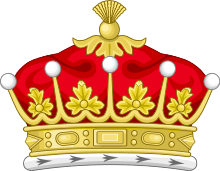Earl of March
| Earldom of the March (Scottish) | |
|---|---|
  | |
| Creation date | 11th century |
| Monarch | Malcolm III of Scotland |
| Peerage | Peerage of Scotland |
| First holder | Patrick de Dunbar, 8th Earl of March |
| Present holder | Charles Gordon-Lennox, 10th Duke of Richmond |
| Remainder to | the 1st Earl's heirs male of the body lawfully begotten. |
| Subsidiary titles | The Arms of the Realm and Ancient Local Principalities of Scotland [1] |
The title The Earl of March has been created several times in the Peerage of Scotland and the Peerage of England. The title derived from the "marches" or boundaries between England and either Wales (Welsh Marches) or Scotland (Scottish Marches), and was held by several great feudal families which owned lands in those border districts.[2] Later, however, the title came to be granted as an honorary dignity, and ceased to carry any associated power in the marches. The title is now a subsidiary title of the dukes of Richmond and the current duke's eldest son Charles Gordon-Lennox, Earl of March and Kinrara uses it as a courtesy title.
Earls of March in the Peerage of Scotland
The Earls of March on the Scottish border were descended from Gospatric, Earl of Northumbria but being soon afterwards deprived of this position he fled to Scotland, where Máel Coluim III, King of Scotland, welcomed him and granted him Dunbar and the adjoining lands.[2] His successors controlled the Marches, but Earl of March was only assumed as an alternative title to that of Earl of Dunbar by Patrick de Dunbar, 8th Earl of March. The last of his successors was George de Dunbar, 11th Earl of March & Dunbar, whose honours and lands were forfeited to the Crown. He retired into England and died in obscurity.
Following his forfeiture, the next creation of the Earldom of March was for Alexander Stuart, Duke of Albany. At the death of his successor John, the dukedom and earldom became extinct. The next creation was for Robert Stuart, but at his death the earldom again became extinct.
The most recent Scottish creation of the Earldom of March was in 1697 for the Lord William Douglas, a younger son of the first Duke of Queensberry.[2] For more information on this creation, see the Earl of Wemyss and March.
Scottish Earls of March, first Creation
See Earl of Dunbar, for which "Earl of the March" is used as an alternate title.
Scottish Earls of March, second Creation (1455)
- Alexander Stewart, 1st Duke of Albany (c. 1455–1485)
- John Stewart, 2nd Duke of Albany (1481–1536)
Scottish Earls of March, third Creation (1581)
with subsidiary Lord (of) Dunbar (1581)
- Robert Stuart, 1st Earl of March (d. 1586)
Scottish Earls of March, fourth Creation (1697)
see the Earl of Wemyss and March
Earls of March in the Peerage of England
The Earls of March on the Welsh Marches were descended from Roger Mortimer,[2] as there had been no single office in this region since the Earl of Mercia. He forfeited his title, which was in the Peerage of England, for treason in 1330, but his descendant Roger managed to have it restored eighteen years later. With the death of the fifth Earl, however, there remained no more Mortimers who were heirs to the first Earl, and the title passed to Richard Plantagenet, Duke of York. At Richard's death, the titles passed to his son Edward, who would later become King Edward IV, causing the earldom of March to merge into the Crown.
In the Peerage of England, the next creation of the earldom came when Edward Plantagenet, Duke of Cornwall was made Earl of March in 1479. In 1483, he succeeded as King Edward V, and the earldom merged in the crown. Later that year, however, his uncle Richard of Gloucester acceded to the throne as Richard III. The fate of the young Edward and his brother, Richard has never been confirmed.
The next English creation was in favour of Esme Stewart, the third Duke of Lennox. His successors bore the earldom, until the death of the sixth Duke, when both the earldom and the dukedom became extinct. The last English creation was in favour of Charles Lennox, 1st Duke of Richmond and Lennox. His successors have borne the English earldom of March since then.
English Earls of March, first Creation (1328)
- Roger Mortimer, 1st Earl of March (1287–1330) (forfeit 1330)
- Roger Mortimer, 2nd Earl of March (1328–1360) (restored 1348 (barony), 1354 (earldom))
- Edmund Mortimer, 3rd Earl of March (1351–1381)
- Roger Mortimer, 4th Earl of March (1374–1398)
- Edmund Mortimer, 5th Earl of March (1391–1425)
- Richard Plantagenet, 3rd Duke of York (1411–1460)
- Edward Plantagenet, 4th Duke of York (1442–1483) (became King in 1461)
English Earls of March, second Creation (1479)
- Edward, Duke of Cornwall (1470–1483?) (became King in 1483)
English Earls of March, third Creation (1619)
- Esmé Stewart, 3rd Duke of Lennox (1579–1624)
- James Stewart, 1st Duke of Richmond (1612–1655)
- Esmé Stewart, 2nd Duke of Richmond (1649–1660)
- Charles Stewart, 3rd Duke of Richmond (1639–1672)
English Earls of March, fourth Creation (1675)
See Duke of Richmond and Lennox
- The title is held substantively by Charles Gordon-Lennox, 10th Duke of Richmond; his son Charles Gordon-Lennox, Earl of March and Kinrara uses it as a courtesy title.
See also
- Marcher Lords English title for the Welsh Marches
- List of Marcher lordships
References
- ↑ Pottinger, Don; Moncreiffe of that Ilk, Iain (1983), Scotland of old, Edinburgh: Bartholemew, ISBN 0-7028-1709-0,
- 1 2 3 4
 Chisholm, Hugh, ed. (1911). "March, Earls of". Encyclopædia Britannica. 17 (11th ed.). Cambridge University Press. pp. 685–688.
Chisholm, Hugh, ed. (1911). "March, Earls of". Encyclopædia Britannica. 17 (11th ed.). Cambridge University Press. pp. 685–688.